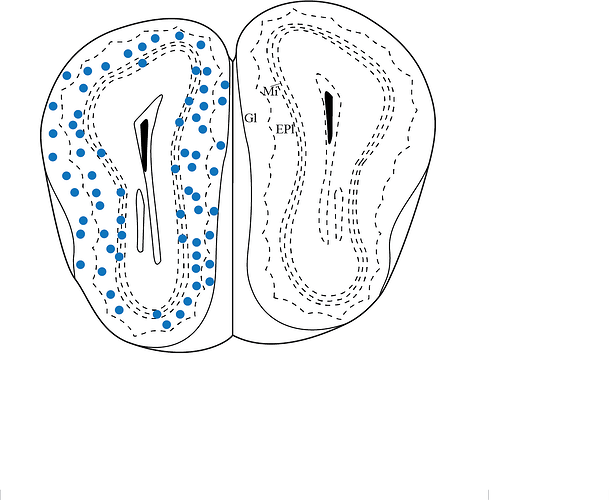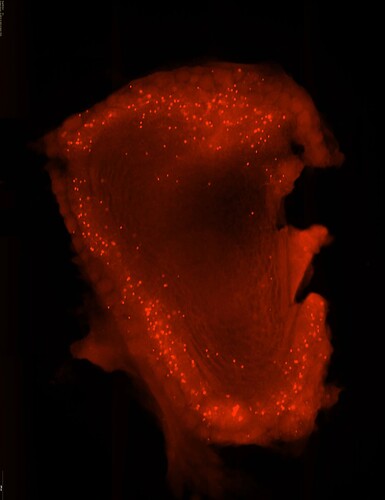Hi everyone ,
I have two groups of pictures of mouse brain sections. These pictures are 2D pictures. I am writing a shiny app to show these two groups of pictures side by side. I have a sliderbar for each group which allows me to check the images in each group one by one and makes sure that there is only one picture from each group displayed on the app. Now I want to create an "interactive connection" between the images between these two groups, which means when I scroll one of the sliderbars, the images from both groups will change accordingly. Does anyone know how to create this "interactive connection" in shiny? Please let me know if you have any idea about it. Any advice is appreciated! Thanks!
Here is my code :
library(shiny)
library(shinydashboard)
library(shinyjs)
library(magick)
library(png)
library(jpeg)
library(webshot)
library(vembedr)
library(shinythemes)
# Sample image paths for multiple mouse lines
dlx1_paths <- c(
"slide1_02Image_02.jpg",
"slide1_02Image_03.jpg",
"slide1_02Image_04.jpg",
"slide1_02Image_05.jpg"
)
dlx2_paths <- c(
"slide1_02Image_06.jpg",
"slide1_02Image_07.jpg",
"slide1_02Image_08.jpg",
"slide1_02Image_09.jpg"
)
dlx3_paths <- c(
"slide1_02Image_10.jpg",
" slide1_02Image_11.jpg",
"slide1_02Image_12.jpg",
"slide1_02Image_13.jpg",
"slide1_02Image_14.jpg"
)
dlx1_atl1 <- c(
"Ai65F-1.jpg",
"Ai65F-2.jpg",
"Ai65F-3.jpg",
"Ai65F-4.jpg"
)
dlx1_atl2 <- c(
"Ai65F-5.jpg",
"Ai65F-6.jpg",
"Ai65F-7_45.jpg",
"Ai65F-8_57.jpg"
)
dlx1_atl3 <- c(
"Ai65F-9_69.jpg",
"Ai65F-10_76.jpg",
"Ai65F-11_81.jpg",
"Ai65F-12_95.jpg"
)
# Combine image paths for all mouse lines
all_image_paths1 <- list(dlx1 = dlx1_paths, dlx2 = dlx2_paths, dlx3 = dlx3_paths)
all_image_paths2 <- list(dlx1 = dlx1_atl1, dlx2 = dlx1_atl2, dlx3 = dlx1_atl3)
# Define UI
ui <- navbarPage(
"Mouse Brain Image Viewer",
theme = shinytheme("flatly"),
tabPanel(
"Home",
fluidRow(
column(6, selectInput(
"mouse_line", "Select Mouse Line", choices = names(all_image_paths1)
),
sliderInput("image_slider1", "Select Image", 1, 1, 1, step =1),
br()
),
column(6,selectInput(
"mouse_linealt", "Select Mouse Line", choices = names(all_image_paths2)
),
sliderInput("image_slider2", "Select Image", 1, 1, 1, step =1),
br()
)
),
fluidRow(
column(6, imageOutput("brain_image1")),
column(6, imageOutput("brain_image2"))
),
tabPanel(
"stat" #includeMarkdown("about.md")
)
)
)
server <- function(input, output, session) {
# Reactive value to store current image
current_image1 <- reactiveVal(NULL)
observe({
# Update image paths based on selected mouse line
image_paths1 <- all_image_paths1[[input$mouse_line]]
# Update slider range based on number of images
updateSliderInput(session, "image_slider1", max = length(image_paths1))
# Initialize current image with the first image
current_image1(magick::image_read(image_paths1[1]))
})
observeEvent(input$image_slider1, {
# Change current image when slider value changes
current_image1(magick::image_read(all_image_paths1[[input$mouse_line]][input$image_slider1]))
})
# Display the current image
output$brain_image1 <- renderImage({
if (!is.null(current_image1())) {
# Save the current image to a temporary file with a transparent background
temp_file1 <- tempfile(fileext = ".jpg")
magick::image_write(current_image1(), path = temp_file1, format = "jpg")
list(
src = temp_file1,
contentType = "image/jpg",
width = "100%",
height = "auto"
)
}
}, deleteFile = TRUE) # Delete the temporary file after rendering
current_image2 <- reactiveVal(NULL)
observe({
# Update image paths based on selected mouse line
image_paths2 <- all_image_paths2[[input$mouse_linealt]]
# Update slider range based on number of images
updateSliderInput(session, "image_slider2", max = length(image_paths2))
# Initialize current image with the first image
current_image2(magick::image_read(image_paths2[1]))
})
observeEvent(input$image_slider2, {
# Change current image when slider value changes
current_image2(magick::image_read(all_image_paths2[[input$mouse_linealt]][input$image_slider2]))
})
# Display the current image
output$brain_image2 <- renderImage({
if (!is.null(current_image2())) {
# Save the current image to a temporary file with a transparent background
temp_file2 <- tempfile(fileext = ".jpg")
magick::image_write(current_image2(), path = temp_file2, format = "jpg")
list(
src = temp_file2,
contentType = "image/jpg",
width = "100%",
height = "auto"
)
}
}, deleteFile = TRUE)
}
# Run the application
shinyApp(ui, server)

